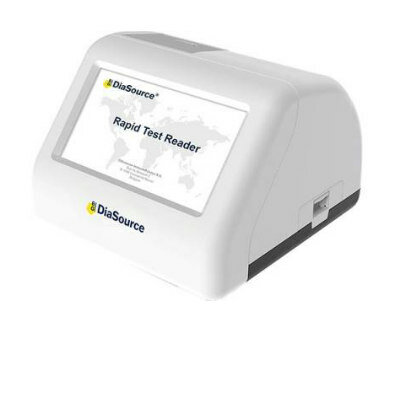Noninvasive Fluorescent Molecular Imaging Probes Identify Lymph Node Metastasis
By LabMedica International staff writers
Posted on 31 Jan 2012
Using two cell surface markers found to be highly expressed in breast cancer lymph node metastases, scientists have developed targeted, fluorescent molecular imaging probes that can noninvasively detect breast cancer lymph node metastases. The new procedure could spare breast cancer patients invasive and ineffective sentinel lymph node (SLN) biopsies and surgery-associated negative side effects.Posted on 31 Jan 2012
Their study was published in the January 1, 2012, issue of the journal Clinical Cancer Research, a publication of the American Association for Cancer Research. “The majority of breast cancer patients, up to 74%, who undergo SLN biopsy are found to be negative for axillary nodal, or ALN, metastases,” said corresponding author David L. Morse, PhD, an associate member at the Moffitt Cancer Center (Tampa, FL, USA) whose research fields include experimental therapeutics and diagnostic imaging. “Determining the presence or absence of ALN metastasis is critical to breast cancer staging and prognosis. Because of the unreliability of the SLN biopsy and its potential for adverse effects, a noninvasive, more accurate method to assess lymph node involvement is needed.”
The investigators noted that the postoperative complications to the SLN biopsy can include lymphedema, seroma formation, sensory nerve injury, and limitations in patient range of motion. In addition, biopsies fail to identify disease in axillary lymph nodes in 5%-10% of patients.
In developing targeted molecular probes to detect breast cancer in axillary lymph nodes, the researchers from Moffitt, the University of Arizona (Tucson, USA), and University of Florida (Gainesville, USA) utilized two surface cell markers--CAIX and CAXII (overexpression of carbonic anhydrase IX and XII). CAIX is a cell surface marker known to be “highly and broadly expressed in breast cancer lymph node metastases” and absent in normal tissues.
CAIX and CAXII are both integral plasma membrane proteins with large extracellular components that are accessible for binding of targeted imaging probes, explained Morse. In addition, several studies have shown that CAIX expression is associated with negative prognosis and resistance to chemo and radiation therapy for breast cancer. CAXII is a protein expressed in over 75% of axillary lymph node metastases.
The researchers then went on to develop their targeting agents by using monoclonal antibodies specific for binding CAIX and CAXII, both of which are known to promote tumor growth.
According to the researchers, a number of noninvasive optical imaging modalities for SLN evaluation have been studied, but the approaches have lacked the ability to target tumor metastasis biomarkers. “These methods provide only anatomic maps and do not detect tumor cells present in lymph nodes,” explained Dr. Morse. “Using mouse models of breast cancer metastasis and a novel, monoclonal antibody-based molecular imaging agents, we developed a targeted, noninvasive method to detect ALN metastasis using fluorescence imaging.”
In addition to the imaging study with mice, the researchers also reported that the combination of CAIX and CAXII covered 100% of patient-donated samples used in their tissue microarray (TMA) study.
“The imaging probes detected tumor cells in ALNs with high sensitivity,” explained Dr. Morse. “Either CAIX or CAXII were expressed in 100% of the breast cancer lymph node metastasis samples we surveyed in this study. These imaging probes have potential for providing a noninvasive way to stage breast cancer in the clinic without unneeded and costly surgery.”
Related Links:
Moffitt Cancer Center
University of Arizona
University of Florida













